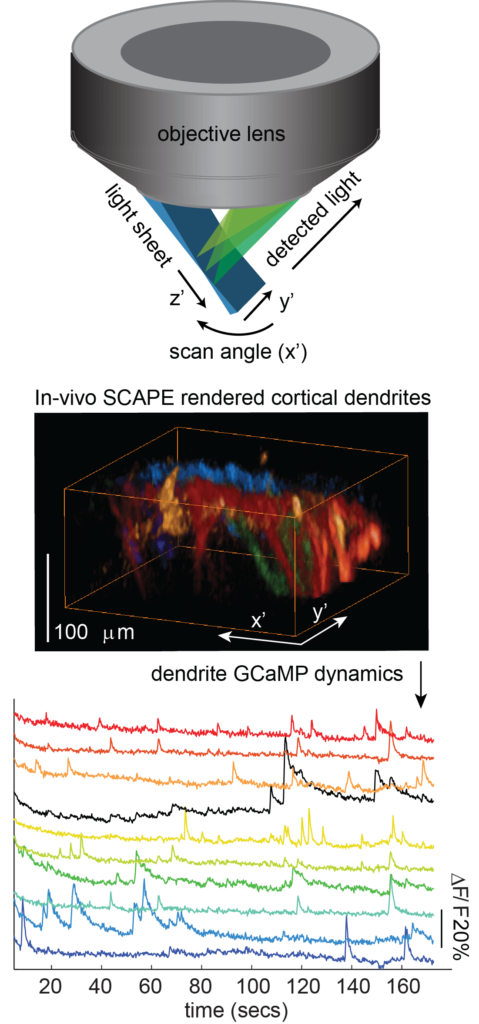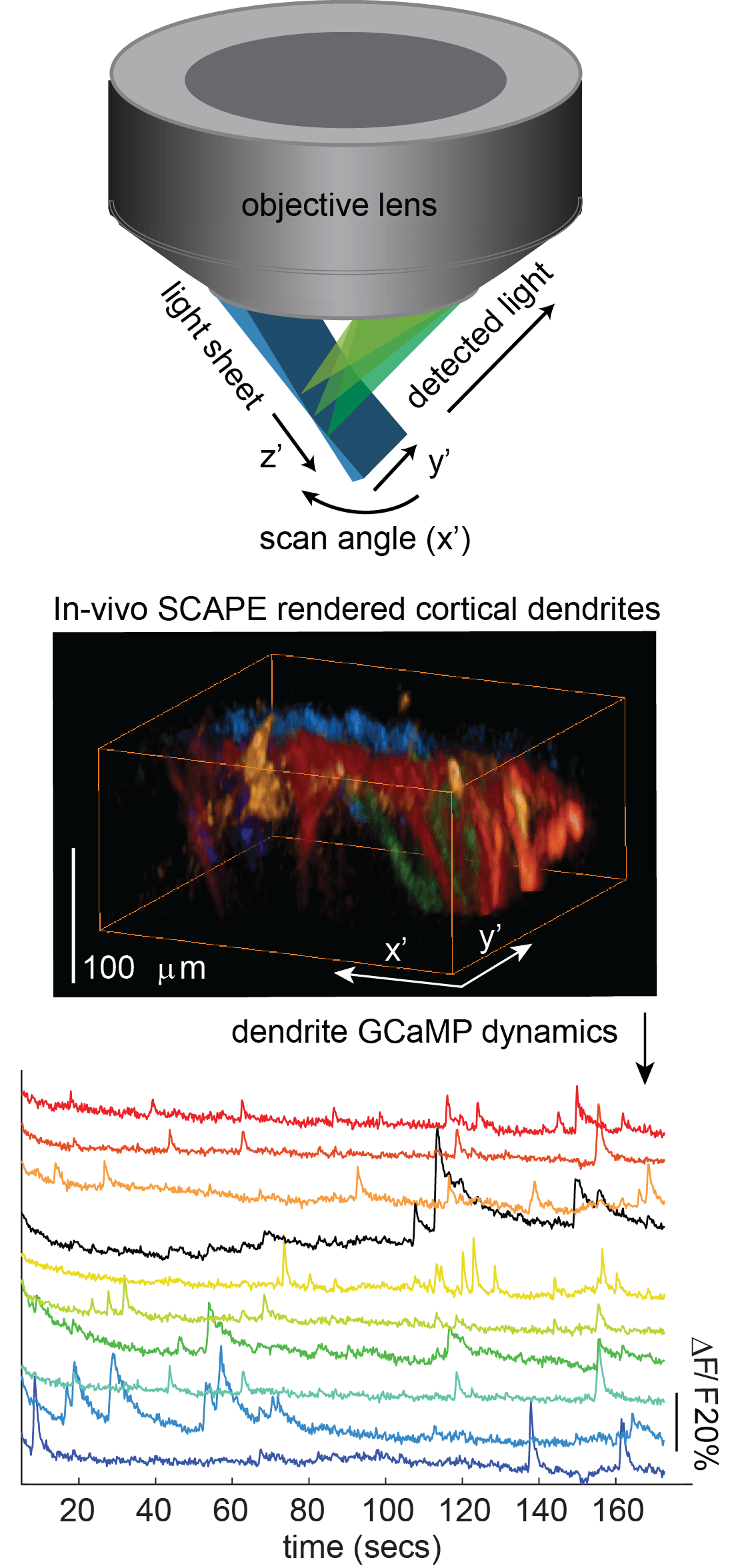
Microscopy system is faster, simpler, and cheaper
Opening new doors for biomedical and neuroscience research, Elizabeth Hillman, associate professor of biomedical engineering at Columbia Engineering and of radiology at Columbia University Medical Center (CUMC), has developed a new microscope that can image living things in 3D at very high speeds. In doing so, she has overcome some of the major hurdles faced by existing technologies, delivering 10 to 100 times faster 3D imaging speeds than laser scanning confocal, two-photon, and light-sheet microscopy. Hillman’s new approach uses a simple, single-objective imaging geometry that requires no sample mounting or translation, making it possible to image freely moving living samples. She calls the technique SCAPE, for swept confocally aligned planar excitation microscopy. Her study is published in the Advance Online Publication (AOP) on Nature Photonics’s website on January 19, 2015.
“The ability to perform real-time 3D imaging at cellular resolution in behaving organisms is a new frontier for biomedical and neuroscience research,” says Hillman, who is also a member of Columbia’s Mortimer B. Zuckerman Mind Brain Behavior Institute. “With SCAPE, we can now image complex, living things, such as neurons firing in the rodent brain, crawling fruit fly larvae, and single cells in the zebrafish heart while the heart is actually beating spontaneously—this has not been possible until now.”
Highly aligned with the goals of President Obama’s BRAIN Initiative, SCAPE is a variation on light-sheet imaging, but, “It breaks all the rules,” says Hillman. While conventional light-sheet microscopes use two awkwardly positioned objective lenses, Hillman realized that she could use a single-objective lens, and then that she could sweep the light sheet to generate 3D images without moving the objective or the sample. “This combination makes SCAPE both fast and very simple to use, as well as surprisingly inexpensive,” she explains. “We think it will be transformative in bringing the ability to capture high-speed 3D cellular activity to a wide range of living samples.”
SCAPE is an urgently needed breakthrough.
Read more: New High-Speed 3D Microscope—Scape—Gives Deeper View of Living Things
The Latest on: 3D Microscope
[google_news title=”” keyword=”3D Microscope” num_posts=”10″ blurb_length=”0″ show_thumb=”left”]
via Google News
The Latest on: 3D Microscope
- ZEISS Xradia 410 Versa 3D X-Ray Microscope from Carl Zeisson April 26, 2024 at 5:00 pm
The ZEISS Xradia 410 Versa encompasses all the benefits of the VersaXRM family of 3D X-ray microscopes for computed tomography. Xradia 410 Versa is uniquely designed to bridge cost/performance ...
- The world’s first face-and-eye transplanton April 26, 2024 at 7:15 am
Surgeons have used advanced technology to complete the first face-and-eye transplant. 3D-printed cutting guides were used to access the donor's orbital socket. High-powered microscopes and ...
- SkyWater Technology Is Lowering Barriers To Advanced Chip Packagingon April 23, 2024 at 3:00 am
SkyWater has partnered with Deca Technologies to develop a multi chip packaging capability that will lower the entry barriers to advanced packaging.
- New super-resolution microscopy approach visualizes internal cell structures and clusters via selective plane activationon April 22, 2024 at 9:08 am
To study living organisms at ever smaller length scales, scientists must devise new techniques to overcome the so-called diffraction limit. This is the intrinsic limitation on a microscope's ability ...
- A 3D endo-microscope for early cancer diagnosison April 17, 2024 at 11:16 pm
Researchers at the University of Nottingham have created an endoscopic device that can 3D image the stiffness of individual biological cells and complex organisms, a discovery that could help doctors ...
- A better view with new mid-infrared nanoscopyon April 17, 2024 at 2:42 am
A team at the University of Tokyo have constructed an improved mid-infrared microscope, enabling them to see the structures inside living bacteria at the nanometer scale. Mid-infrared microscopy is ...
- New technological advance for fast and efficient 3D imaging of objectson April 10, 2024 at 5:00 pm
polarization or confocal microscopes. We hope that by intelligently interrogating the sample, we can further improve current systems to characterize 3D samples with unprecedented accuracy and ...
- The best microscopes for students in 2024on April 10, 2024 at 1:00 pm
Here are the microscopes to help them get started. This classic microscope is made with students’ needs in mind. It can connect to a laptop or other screen for group viewing, helping large ...
- Best microscopes for kids 2024on April 4, 2024 at 6:32 am
Thanks to a pair of complementary LED lights, you can use this microscope to view slides or 3D objects with the flip of a switch. It's best for viewing internal cell structures, skin and tissue ...
- Researchers add swept illumination to open-top light-sheet microscopeon March 20, 2024 at 12:59 pm
The researchers used their improved open-top light-sheet microscope to capture images of densely labeled clinical specimens, showing its potential for nondestructive 3D pathology. Kevin W.
via Bing News










